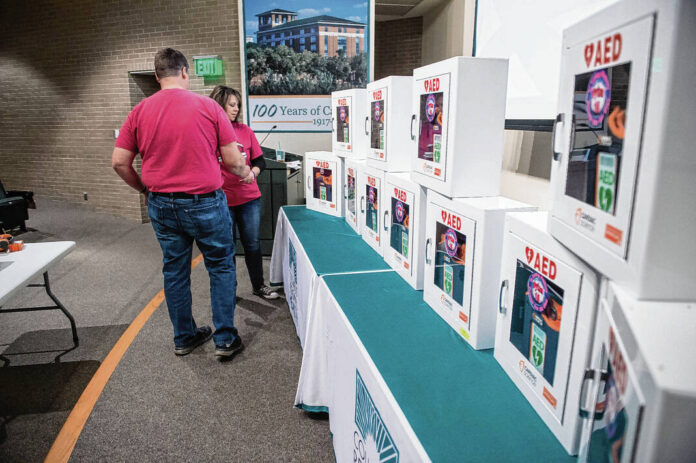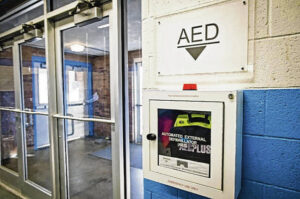
Erick and Georgiana Williams look over 10 automated external defibrillators, or AEDs, that were to be given to various sports venues throughout the county at Columbus Regional Hospital in February 2017.
The Republic file photo
Twenty-four years ago last week, Lawrence North basketball standout John Stewart collapsed and died during a regional basketball game against Bloomington South at Columbus North.
Like most high schools across Indiana at the time, North did not have automated external defibrillators, or AEDs, in place at the time. Emergency medical personnel tried to revive the 7-foot, 275-pound Stewart for about 25 minutes before he was taken to Columbus Regional Hospital, where he was pronounced dead, a victim of idiopathic hypertrophic cardiomyopathy.
Soon after that, lawmakers began a push to ensure that all schools were equipped with AEDs. Now, they’re taking it a step further, seeking AEDs to be present at all indoor and outdoor sporting events.
Senate Bill 369, whose authors include Sen. Greg Walker, R-Columbus, would require school coaches, marching band leaders and extracurricular activity leaders to ensure that an operational AED is present at all athletic events. The bill would require the devices to be accessible within three minutes, except in cross country.
The bill also would require schools to maintain the devices and develop and communicate venue-specific emergency action plans in the event of a cardiac arrest.
The bill sailed through the Indiana Senate last month on a vote of 49-0 and is pending in the Indiana House.
Defibrillators have “changed a lot the past five or six years, maybe 10 years,” said Steve Souder, who spent 43 years as athletic trainer at Columbus North and the past two years at Hauser. “John Stewart, when he passed away, they were non-existent. The only ones that had them were EMTs or paramedics.”
 Lawrence North basketball star John Stewart’s death during a regional game at Columbus North in 1999 sparked schools across the state to obtain defibrillators to place in or near their gymnasiums, such as this one at Columbus North, pictured Tuesday, March 11, 2014.
Lawrence North basketball star John Stewart’s death during a regional game at Columbus North in 1999 sparked schools across the state to obtain defibrillators to place in or near their gymnasiums, such as this one at Columbus North, pictured Tuesday, March 11, 2014.
The Republic file photo
The Bartholomew County schools have had AEDs, which run about $1,800 apiece, for several years. North has them in the main gym, pool area and the baseball and softball complex and a portable one to be taken to the football field.
Columbus East has AEDs just outside its main and auxiliary gyms, pool area and outside the main office and a portable one that can be taken to the football, baseball and softball fields. Both schools’ trainers also take a portable AED to games at the BCSC Soccer Complex.
“Trainers keep portable ones with them at all times,” East athletics director Pete Huse said. “There are state laws about where they need to be positioned, and I do know that we meet code. We have them placed where they would meet code for all our athletic events.”
Hauser has AEDs in its main gym, fieldhouse, training room, main office and elementary school. Souder said the school is working on getting one for the softball field, as well, and that he has been taking portable ones to softball and baseball games.
“We do have quite a few in the building,” Souder said. “It was that way at North, too. If I know there isn’t a trainer there at the event (on the road), I will bring one with me, but that’s very seldom anymore.”
Souder did mention, however, that if the bill becomes law, the demand for AEDs likely will be greater than the current supply and that their may be a waiting period of six months or a year until some schools receive them.
All certified employees and coaches have to be trained to use AEDs to keep their license active. Also, all coaches have to take a sudden cardiac arrest course through the National Federation of High Schools (NFHS).
“The new ones, they walk you through everything,” North athletics director Brian Lewis said. “Anyone off the streets can do it. If another adult sees someone having issues, then of course (they can use it).”
Huse agreed.
“Once you start the process, it will talk you through it,” Huse said. “So the person is calm and listening. If you put the pads incorrectly, it will tell you. It will let you know when it’s ready to deliver a charge. The way an AED machine works, it has it to where anyone can use it to save someone’s life if they follow the directions.”




